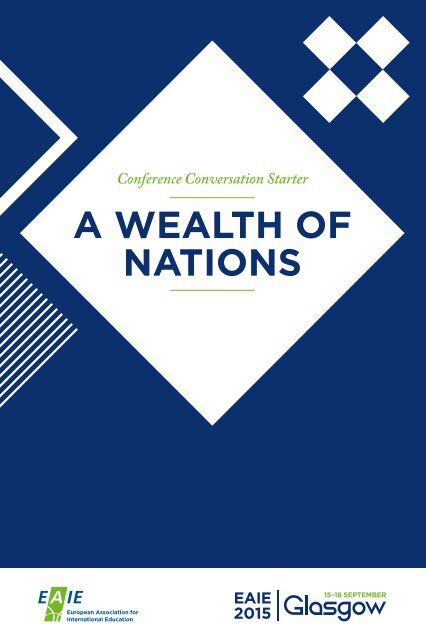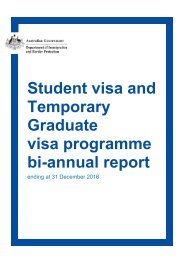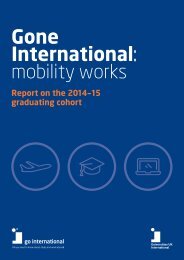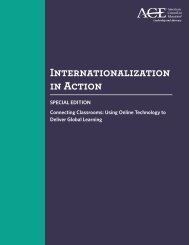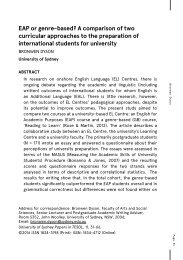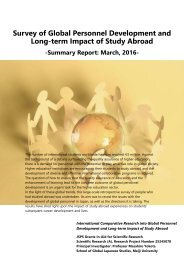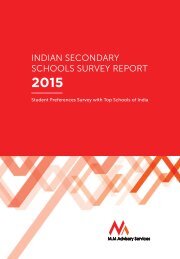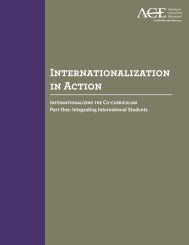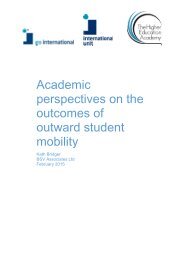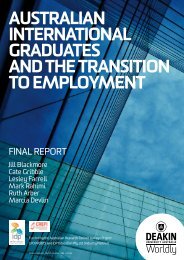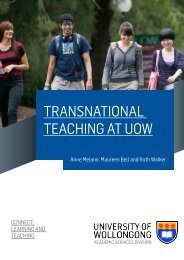A WEALTH OF NATIONS
(eaie)%20icg%20on%20nordig%20region%20fees%20-%20fall%202015
(eaie)%20icg%20on%20nordig%20region%20fees%20-%20fall%202015
Create successful ePaper yourself
Turn your PDF publications into a flip-book with our unique Google optimized e-Paper software.
Conference Conversation Starter<br />
A <strong>WEALTH</strong> <strong>OF</strong><br />
<strong>NATIONS</strong>
iii<br />
Table of Contents<br />
v<br />
Foreword<br />
Laura E. Rumbley, EAIE Publications Committee Chair<br />
01 Introduction<br />
Leasa Weimer, EAIE Knowledge Development Adviser<br />
Adam Smith economics and international higher education<br />
05 Adam Smith on international education in The Wealth of Nations<br />
Craig Smith, School of Social and Political Sciences at the University of Glasgow<br />
11 The health of nations: Adam Smith, internationalisation and<br />
sustainable learning outcomes for the 21st century<br />
Scott G. Blair, Transnational Learning Consulting<br />
Tuition fees in Europe<br />
17 Exploring the Nordic Region’s experiences with<br />
international tuition fees<br />
Daniel J. Guhr and Nelson Furtado, Illuminate Consulting Group<br />
23 Education is a right and not a privilege: a Finnish student union<br />
perspective on tuition fees<br />
Taina Moisander, Union of Students in Finnish Universities of<br />
Applied Sciences (SAMOK)<br />
29 The international student tuition-fee question in France<br />
Ariane de Gayardon de Fenoyl, Center for International Higher Education at<br />
Boston College<br />
A wealth of knowledge<br />
37 The potential of knowledge diplomacy? Higher education and<br />
international relations<br />
Jane Knight, Ontario Institute for Studies in Education, University of Toronto<br />
45 Exploring the future global flows of knowledge and mobility:<br />
implications for international education<br />
Angel Calderon, RMIT University<br />
53 About the authors
17<br />
TUITION FEES IN EUROPE<br />
Exploring the Nordic Region’s<br />
experiences with international<br />
tuition fees<br />
— Daniel J. Guhr and Nelson Furtado<br />
Illuminate Consulting Group<br />
PROLOGUE<br />
About a decade ago, the Nordic Region would not have been considered a hot bed for<br />
discussions on international tuition fees. Yet by 2015, things have changed fundamentally.<br />
Two Nordic countries – Denmark in 2006 and Sweden in 2011 – have introduced<br />
tuition fees for students from outside the European Union (EU) and European<br />
Economic Area (EEA). Finland concluded a voluntary tuition-fees pilot in 2014 and<br />
has tentatively announced the introduction of international student tuition fees for<br />
2016. Norway experienced two cycles of fee discussions, only to shelve the topic. Iceland<br />
remains the only country with a persistent no-fees approach.<br />
How and why did the Nordic Region relatively quickly become a locus for policy<br />
development on international tuition fees in Europe? What are the implications of this<br />
shift, both for higher education systems and for society as a whole? This article reflects<br />
on these questions in three ways. First, it comments on international student inbound<br />
mobility into the Nordic Region relative to fee developments. A second section discusses<br />
institutional and policy-making viewpoints with the aim to provide contextual perspectives.<br />
The article concludes with a discussion on what the move towards tuition fees in<br />
the Nordic Region means from a larger European vantage point.<br />
INTRODUCTION: INTERNATIONAL STUDENTS IN THE NORDIC REGION<br />
In 2000, international degree-seeking student enrolments in four Nordic countries –<br />
Denmark, Finland, Norway, and Sweden – stood at around 5000 each, with a few hundred<br />
enrolled in Iceland. These figures are quite small when compared with enrolment<br />
figures for the same timeframe in, for example, the United States (around 515 000) or<br />
Germany (around 175 000).
18<br />
Since then, Nordic countries have experienced strong enrolment growth. By 2013, the<br />
number of international degree-seeking students in the Nordic Region exceeded<br />
80 000 – more than tripling the number of students enrolled in 2000, despite the enrolment<br />
drop of international students in Sweden following the introduction of tuition<br />
fees there in 2011. This rate of growth by far outstripped growth rates in countries such<br />
as the USA and Germany.<br />
Figure 3.1 INTERNATIONAL DEGREE-SEEKING HIGHER EDUCATION<br />
STUDENT ENROLMENT IN THE NORDIC COUNTRIES, 2000–2013<br />
35 000<br />
30 000<br />
25 000<br />
20 000<br />
15 000<br />
10 000<br />
5 000<br />
0<br />
2000<br />
2001<br />
2002<br />
2003<br />
2004<br />
2005<br />
2006<br />
2007<br />
2008<br />
2009<br />
2010<br />
2011<br />
2012<br />
2013<br />
Sweden<br />
Denmark<br />
Finland<br />
Iceland<br />
Norway<br />
Notes: Only full-degree students are displayed for better comparability of national data<br />
sets. Data are not available for all countries for all years displayed.<br />
Source: CIMO, SIU, UFM, UKA, UoI.<br />
In the near future, the Nordic Region appears poised to host more than 100 000 international<br />
degree-seeking students. A large majority of these students will continue to<br />
enrol in English-language Master’s programmes. Small cohorts can be expected to enrol<br />
in domestic-language Bachelor’s programmes or emerging English-language Bachelor’s<br />
programmes. Others will enrol in doctoral programmes, though these students often<br />
would be considered university employees, making enrolment comparisons difficult.<br />
INTERNATIONAL TUITION FEES IN DENMARK<br />
Denmark introduced tuition fees for students from countries outside of the EU/<br />
EEA and Switzerland in 2006. The policy objective of introducing fees was to avoid<br />
subsidising higher education for non-EU/EEA students, as well as to attract talented<br />
international students with the help of scholarships. At the doctoral level, many
19<br />
international students study under studentships or fellowships wherein they are treated<br />
by universities as salaried employees, with no tuition-fee responsibilities. However,<br />
those seeking Doctorate degrees may also enrol as ‘independent doctoral students’ not<br />
employed by the university, in which case they are responsible for funding their studies,<br />
including tuition fees.<br />
Danish universities calculate international tuition fees on a cost basis and are entitled<br />
to set fees at cost-plus levels – with the surplus being allocated to scholarships or other<br />
student support measures. Students who are required to pay fees face annual tuition levels<br />
ranging from DKK 45 000 to DKK 125 000 (€6000 to €16 750 1 ). Higher education<br />
in Denmark remains free of tuition for full-time domestic and EU/EEA students.<br />
Danish universities are allocated government funds to provide merit-based scholarships<br />
for full-degree students from non-EU/EEA countries, with the funding ceiling for<br />
each university determined by the Danish Agency for Higher Education. International<br />
students are not eligible for student loans in Denmark.<br />
In the year following the introduction of tuition fees, the intake of non-EU/EEA<br />
students declined 35% and has remained relatively flat since. The Danish Ministry of<br />
Higher Education and Science in 2012 indicate a total enrolment of just around 1200<br />
fee-paying students. This low figure reflects differentiated institutional responses to tuition<br />
fees; some emphasised the recruitment of EU/EEA students, while others focused<br />
on incoming exchange students (who cannot be charged tuition fees).<br />
The rising imbalance of incoming and outgoing exchange students did not go unnoticed<br />
by the Danish government. A few years ago, the government attempted to instil an<br />
‘economic balance’ between incoming and outgoing students by proposing universities<br />
fund any imbalance out of their own budgets.<br />
Another governmental policy response emerged in 2015 regarding the number of Master’s<br />
programme seats within Denmark: the introduction of enrolment caps for specific<br />
fields of study. These caps will apply to non-fee-paying and fee-paying students alike,<br />
despite the fees contributions of the latter.<br />
INTERNATIONAL TUITION FEES IN FINLAND<br />
Since 2010, Finland has experienced the most complex tuition fees landscape of any<br />
Nordic – and for that matter, European – country. Currently, Finnish higher education<br />
institutions do not charge students tuition fees, regardless of nationality. During<br />
a 2010–2014 trial period, however, institutions could charge fees to non-EU/EEA<br />
students in Master’s programmes not taught in Finnish. In 2014, the Ministry of<br />
Education and Culture reported that nine universities and 10 polytechnics participated,<br />
charging fees for just over 40 programmes. The tuition-fees pilot programme also stipulated<br />
that institutions charging fees had to offer scholarships concurrently. Many Finnish<br />
institutions opted not to participate because they did not have the infrastructure in<br />
place to effectively disburse scholarships.<br />
1 Currency equivalencies throughout the essay reflect 10 June 2015 exchange rates.
20<br />
An attempt to introduce international student fees more generally in 2014 ultimately<br />
was withdrawn before a vote in the Finnish Parliament. Following the national election<br />
in May 2015, the newly formed Finnish government proposed introducing tuition<br />
fees for non-EU/EEA students commencing degree studies (taught in English only) in<br />
Finland, most likely in the autumn of 2016, with a minimum fee level of €4000 per year.<br />
The proposal was opposed by student unions and the Union of University Researchers<br />
and Teachers. Most Finnish institutions, however, supported the introduction of fees,<br />
but wished to retain the authority to set fee levels themselves.<br />
INTERNATIONAL TUITION FEES IN ICELAND<br />
Regardless of the nationality of a student, public institutions in Iceland do not charge<br />
tuition fees and only levy a small compulsory annual registration fee. For example, the<br />
University of Iceland charged a registration fee of ISK 75 000 (€500) for the 2014–2015<br />
academic year.<br />
Despite the absence of tuition fees, Iceland’s flagship university, the University of<br />
Iceland, does not market itself as ‘tuition free’. As Fridrika Hardardottir, the International<br />
Director, reports, the University’s emphasis has been on building exchanges and<br />
recruiting degree-seeking students, mostly at the Master’s level, but also at the doctoral<br />
level (specifically in programmes featuring English-language instruction).<br />
In terms of exchanges, the University draws students through schemes such as the<br />
Erasmus+ and Nordplus programmes, as well as numerous bilateral agreements. Fulldegree-seeking<br />
students are attracted by a variety of factors, such as the University’s<br />
unique programmes, the novelty of studying in Iceland and the country’s increasing<br />
economic development.<br />
INTERNATIONAL TUITION FEES IN NORWAY<br />
Currently, Norwegian higher education institutions do not charge students tuition<br />
fees, regardless of nationality. In October 2014, the Norwegian government proposed<br />
introducing tuition fees for non-EU/EEA students in its 2015 budget – the second<br />
tuition-fee proposal after a rapidly terminated previous policy proposal. In particular,<br />
the proposal cut NOK 80.5m (€9m) in funding for universities and colleges, with the<br />
expectation that tuition fees would compensate for the difference.<br />
The proposal was heavily opposed by higher education institutions, which believed fees<br />
would be detrimental to their efforts to attract international students. Student organisations,<br />
some of which considered international tuition fees a harbinger of fees for domestic<br />
students, likewise protested the change.<br />
In a unique response, Norwegian universities proposed funding the budget cut on their<br />
own, rather than charging tuition fees, in effect rendering the government’s incomeoffset<br />
expectation null and void. In November 2014, the Norwegian government<br />
announced the retraction of the proposal.
21<br />
In 2015, policy makers affirmed that Norwegian higher education institutions would<br />
remain tuition-free for non-EU/EEA students. This decision was widely welcomed<br />
by Norwegian universities, which have to contend with one of the highest costs of<br />
living worldwide.<br />
But not all Norwegian universities are tuition-free. The Norwegian Business School<br />
(BI) has charged tuition fees since its establishment as a private institution in 1943.<br />
BI enrols around 10 500 students; approximately 1500 are international students, and<br />
around 750 enrol as degree-seeking students. Annual fee levels – for all students – run<br />
at NOK 70 000 (€8000) for Bachelor’s programmes and NOK 75 000 (€8600) for<br />
Master’s programmes.<br />
INTERNATIONAL TUITION FEES IN SWEDEN<br />
In June 2010, the Swedish parliament voted in favour of a government proposal to introduce<br />
fees for students from outside the EU/EEA and Switzerland. Underpinning the<br />
move was the goal of ensuring the Swedish higher education system’s competitiveness<br />
in terms of the quality of its education offerings, rather than a concern for attracting<br />
international students by continuing to provide free education for international students.<br />
Tuition fees came into effect in the fall of 2011.<br />
The law granted Swedish higher education institutions the right to determine the level<br />
of fees to be levied, with a floor equal to the governmental contribution to a student<br />
seat. International tuition fees in Sweden range from SEK 80 000 to SEK 150 000<br />
(€8600 to €16 000) per year, with a few more-costly outliers. International doctoral<br />
students are considered university employees; therefore, tuition fees do not apply.<br />
Following the introduction of fees, non-EU/EEA student intake initially decreased<br />
by more than 50%, resulting in an enrolment drop of nearly 30%, according to data<br />
from the Swedish Higher Education Authority. Since then, some institutions (eg Lund<br />
University) have seen their non-EU/EEA enrolments increase following a substantial<br />
international recruitment push and targeted use of international scholarships.<br />
In addition to existing Swedish Institute-administered scholarships, the government<br />
introduced two new merit-based scholarship programmes: The Swedish Tuition Fee<br />
Waiver and the Swedish Institute Study Scholarships. These programmes received a<br />
combined SEK 110m (€12m) in funding in 2012.<br />
In the fall of 2014, a newly elected, minority Social Democratic national government<br />
briefly considered dropping fees before reversing itself. Many universities strongly opposed<br />
such a move, given their investments into a fee-based recruiting landscape. In addition,<br />
the government would have had to reimburse the institutions for a loss of fee income,<br />
which was politically not prudent in a time of budgetary pressures. Sweden offers<br />
a poignant case study on the enrolment impact of a hasty introduction of international<br />
tuition fees. The collapse of the non-EU/EEA student intake was substantially driven by<br />
timing issues: the window of less than half a year between the legal introduction of fees<br />
and the start of the recruiting cycle for the coming academic year proved fundamentally<br />
insufficient for most, if not all, Swedish universities.
22<br />
Preliminary 2014 data suggests that Sweden will experience a more broadly based recovery<br />
of non-EU/EEA student intake, though the pre-fee heights of the 2011 will not be<br />
reached any time soon.<br />
INTERNATIONAL TUITION FEES IN THE NORDIC REGION:<br />
STRATEGIC CONSIDERATIONS<br />
The Nordic Region was an unlikely candidate for the introduction of international<br />
tuition fees, yet it has moved ahead of much of continental Europe by either introducing<br />
fees or seriously discussing their introduction. It is quite possible that the entire<br />
Nordic Region will operate with fees – of varying levels and under distinct regulatory<br />
models – a decade from now.<br />
The foremost driver for the introduction of tuition fees via governmental policy was<br />
the potential financial contributions from degree-seeking non-EU/EEA students.<br />
The reasoning was based on international students not having contributed to a given<br />
society’s higher education infrastructure through (family) tax payments. Thus, tuition<br />
fees were seen to provide a social contribution equalisation function. It should be<br />
noted that the numbers of fee-paying international students in Denmark and Sweden<br />
have remained small. As a result, national tuition-fee revenues constitute a very small<br />
contribution to the overall higher education budgets in those countries.<br />
Political optics matter, too, especially in the light of discussions on the future of<br />
respective welfare state models and their accessibility to non-citizens. Higher education<br />
seats in the Nordic Region are expensive to provide, and international students<br />
are increasingly assumed to be able to contribute the full cost of their education. Since<br />
international students do not vote or otherwise carry notable political clout, politicians<br />
encounter few structural obstacles to introducing international student fees.<br />
A third driver has been the comparatively little-discussed need to properly price the<br />
attainment of a quality good such as a Master’s degree from a Nordic university according<br />
to its proper ‘market rate’. Tuition fees benchmarking can establish such rates<br />
(or ranges) for a given programme with a fair amount of precision, not least because<br />
many other peer programmes in long-standing tuition-fee systems have already been<br />
set according to this approach. In this sense, the Nordic Region is simply catching up.<br />
The introduction of tuition fees in Denmark and Sweden, their impending introduction<br />
in Finland and the discussion in Norway have been accompanied by opposition<br />
to international student fees from student unions, academics and some politicians.<br />
Yet the developments of the last few years beg the question whether such resistance<br />
will be successful: it seems the tide has turned towards the introduction of tuition<br />
fees. Consequently, Nordic stakeholders would be well advised to focus on making fee<br />
introductions as smooth as possible, to develop proper programme-based fee levels,<br />
to introduce intelligent scholarship management, to reset marketing and recruiting<br />
efforts and to offer attractive, high-quality programmes.
53<br />
About the authors<br />
Scott G. Blair, PhD, consults in learning outcomes assessment and educational<br />
sustainability at Transnational Learning Consulting, LLC. Currently active in the<br />
Research and Scholarship Network Leader for the Teaching, Learning and Scholarship<br />
Knowledge Community of NAFSA and member of the board of directors of the<br />
National Society for Experiential Education (NSEE), he also designed and directed<br />
study abroad programmes in Paris as Director of Assessment and Academic Dean<br />
for CEA. A teacher of history and human rights, he served on the faculties of the<br />
University of New Haven in Connecticut (USA), the Paris Institute of Political Studies<br />
(Sciences Po) and Paris Langues. He holds a Doctorate in history from the Sorbonne<br />
and presents and publishes regularly on learning outcomes assessment and sustainable<br />
programme design in education abroad.<br />
Angel Calderon is Principal Advisor in Planning and Research at RMIT University,<br />
Melbourne, and was previously Manager of Statistical Services at Monash University,<br />
Melbourne. He has worked as a journalist in several countries and was Co-editor of<br />
the Journal of Higher Education Policy and Management and the Journal of Institutional<br />
Research in Australasia. His research interests include: higher education policy, international<br />
education, emerging markets, graduate outcomes, benchmarking, university<br />
rankings and the impacts of trade liberalisation on educational services. He is Co-editor<br />
of a book, Institutional Research and Planning in Higher Education. Global Contexts and<br />
Themes, published by Routledge in 2015.<br />
Nelson Furtado has been an analyst with Illuminate Consulting Group since 2013.<br />
Previously, he worked for the Canadian Department of Foreign Affairs and<br />
International Trade, where he supported the work of the Advisory Panel on Canada’s<br />
International Education Strategy. He has also worked for the Ontario Ministry of<br />
Training Colleges and Universities, conducting research on issues such as access to<br />
higher education. He holds a BA with honours in communication studies from<br />
Carleton University in Ottawa.<br />
Ariane de Gayardon de Fenoyl is a research assistant at the Center for<br />
International Higher Education and a PhD student in the Higher Education programme<br />
at Boston College. Her research interests include the relation between access<br />
and tuition, especially in the case of countries that offer tuition-free public higher education.<br />
Before moving to Boston, she was a teaching assistant in the French programme<br />
at King’s College London, where she taught students up to the Bachelor’s level.
54<br />
Daniel J. Guhr, PhD, serves as Illuminate Consulting Group's Managing<br />
Director. Previously, he worked as a strategy consultant with Boston Consulting Group in<br />
Munich and San Francisco and was the Director of Business Development with SAP. He<br />
holds a Doctorate in education and an MSc in educational research methodology from<br />
Oxford, as well as an MA in political science from Brandeis University in Boston. He also<br />
studied political science at the University of Bonn and Harvard. In addition, he served as<br />
a research specialist at the University of California, Berkeley, and conducted research at a<br />
Max Planck Institute. He has authored more than 40 reports, papers and studies and has<br />
contributed to more than 100 conference sessions, seminars and workshops.<br />
Jane Knight, PhD, is an adjunct professor at the Ontario Institute for Studies in<br />
Education (OISE), University of Toronto, and focuses her research on the international<br />
dimension of higher education at the institutional, national, regional and international<br />
levels. Her work with universities, governments and UN agencies in over 70 countries<br />
helps to bring comparative, development and international perspectives to her research,<br />
teaching and policy work. She is the author of numerous publications on internationalisation<br />
concepts and strategies, quality assurance, institutional management, trade,<br />
education hubs, cross-border education and knowledge diplomacy.<br />
Taina Moisander works as an international adviser at the Union of Students in<br />
Finnish Universities of Applied Sciences (SAMOK). She has been involved in policymaking<br />
and advocacy within the student movement since 2009, ranging from the local<br />
to the European level. In Finland, she has focused on questions pertaining to international<br />
students, the internationalisation of higher education and the commodification<br />
of education. On the European level, she has worked on issues related to employability<br />
and the social dimension of higher education at the European Students' Union. She has<br />
a Bachelor's degree in social services.<br />
Craig Smith, PhD, is the Adam Smith Lecturer in the Scottish Enlightenment in the<br />
School of Social and Political Sciences at the University of Glasgow. He is the author<br />
of the monograph Adam Smith’s Political Philosophy: the invisible hand and spontaneous<br />
order and is Co-editor of The Oxford Handbook of Adam Smith. He is also the author of<br />
numerous articles on the Scottish Enlightenment, Book Review Editor of The Adam<br />
Smith Review and serves on the boards of the International Adam Smith Society and<br />
the Eighteenth-Century Scottish Studies Society.<br />
Leasa Weimer, PhD, is the Knowledge Development Adviser for EAIE. With 20<br />
years of higher education experience, she has worn many hats (international student,<br />
practitioner, and researcher) in the field of international education. Leasa holds a PhD<br />
from the University of Georgia (USA), where she received a Fulbright and American<br />
Scandinavian Foundation grant. In 2008, she earned an Erasmus Mundus joint Master’s<br />
degree in higher education policy from the University of Oslo (Norway), the University<br />
of Tampere (Finland), and the University of Aveiro (Portugal). Currently, she serves as<br />
the President of the Erasmus Mundus Student and Alumni Association.


